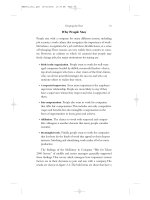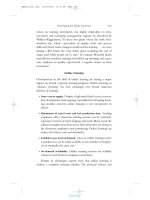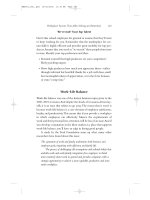Tài liệu Hiring and Keeping the Best People 11 pdf
Bạn đang xem bản rút gọn của tài liệu. Xem và tải ngay bản đầy đủ của tài liệu tại đây (123.23 KB, 8 trang )
Cultural Expectations
People’s expectations about work also strongly influence retention
patterns. In some countries, for example, employees often spend
their entire lifetime working for one firm. Employees, their col-
leagues, and companies consider one another almost as family, and
give each other the same dedication, commitment, and support that
one would give family members. In contrast, the cultures of other
countries emphasize fast-moving and continual change—including
rapid “job-hopping” by workers in search of the best possible com-
bination of work, compensation, and future opportunities. Some
countries’ employment laws—particularly in France, Germany, and
Italy—make it difficult to fire or lay off workers, while in other
regions companies can freely let employees go.
As you might guess, a company’s retention goals might be more
or less challenging depending on the cultural factors that shape its
region’s or industry’s employment trends.
Upheavals in the World of Work
Finally, changing economic and cultural circumstances can produce
dramatic upheavals in the work world. Here are just a few examples:
Keeping the Best 67
FIGURE 3-2
The Aging Work Force
(Projected)
Median Age
in U.S.
50
40
30
1970
20
1980 1990 2000 2010
Source: HMM Retaining Valued Employees.
HBE001_ch3_.qxd 10/02/2002 11:34 AM Page 67
TEAMFLY
Team-Fly
®
•
A trend toward free agency. Free agents—self-employed work-
ers who serve various clients on a temporary, contract basis—
now make up 15 percent of the American work force.
•
The dissolving employer/employee contract.With the wave of
reengineering and restructuring that hit many parts of the
business world in the 1970s and 1980s—and again in the
2000–2002 business downturn—some companies downplayed
the importance of the work force.As a result, old assumptions
about employer paternalism and employee loyalty evaporated.
Today, most workers assume that they must take charge of their
own employability and careers—even if that means moving
from firm to firm. In the United States alone, most people will
hold 8.6 different jobs between the ages of 18 and 32.
•
An intensifying need for technical skills. Economic develop-
ment around the globe, the emergence of the Internet econ-
omy, and accelerating advances in technology in general have
increased the demand for people with advanced technical skills.
With a global marketplace for technical labor, competition will
be intense and come from unlikely quarters.
•
A growth in Internet recruiting.As described in the previous
chapter, the Internet has made it easier for employees to learn
about—and apply for—jobs at other companies.And it’s no
longer just the young folks who are computer savvy enough to
surf the Web for the perfect job.Workers of all ages and back-
grounds are feeling more and more comfortable using the
Internet to explore outside job opportunities.
•
Demands for greater work-life balance. In the United States,
where two-earner households are commonplace, many are
simply fed up with workplace hours and practices that put
corporate needs ahead of personal and family obligations.
Weekend meetings.Vacations interrupted by e-mails from the
office.Too many hotel nights. Long daily commutes. Many
employees, particularly women with young children, are walk-
ing away to take lower-paying jobs nearer to home or finding
other situations that make work-life balance more feasible.
68 Hiring and Keeping the Best People
HBE001_ch3_.qxd 10/02/2002 11:34 AM Page 68
When you put these trends together, it’s clear that companies
can no longer expect employees to join them early in life and stay
indefinitely. Instead, firms must actively and creatively encourage
good people to stay—especially in high-tech markets.
The Special Challenges of a Diverse Work Force
Retention is especially challenging when the work force is highly
diverse. And this is the type of work force that managers in many
parts of the world today face. From age and gender, to part-time ver-
sus full-time status, to ethnicity, race, sexual orientation, and physical
ability—companies are both benefiting from and struggling with
differences among employees.“One-size-fits-all” strategies for keep-
ing good people simply don’t work any longer. Companies can best
improve their retention rates by crafting creative, specialized strate-
gies for each major segment of the work force.
The Contingent Work Force
Members of the “contingent work force”—part-timers, contractors,
and temporary employees—offer some important advantages, as well
as difficult challenges, for managers and HR departments. Primary
advantages include:
•
Flexibility—companies can customize these workers’ schedules
to meet current work flow and demands, using them only
when needed.
•
Affordability—firms save money on payroll taxes, health bene-
fits, and other expenses by employing temps, part-timers, or
freelancers.
Challenges include:
•
High turnover—sometimes as much as 200 to 300 percent—
which introduces unpredictability and instability into the firm’s
culture.
Keeping the Best 69
HBE001_ch3_.qxd 10/02/2002 11:34 AM Page 69
•
A lower degree of loyalty to the firm and its products.
•
A growing demand for the same benefits that regular employ-
ees receive—such as satisfying work and career-development
support.
Because the contingent work force is such a valuable resource, many
companies are now developing programs designed specifically to
retain these employees. For example, one company offers contingent
work force members skills training in exchange for a six-month
commitment.
Younger Workers
Younger workers—primarily those in their twenties—bring energy,
freshness, and state-of-the-art technical knowledge into a firm’s
work force. Demographic trends, in the United States especially,
have created an unprecedented shortage of these workers, who
are often referred to as “Gen-Xers.” These workers pose some
difficulties:
•
Young workers are particularly interested in defining their
career paths and taking jobs that will help them advance to
their next jobs.
•
Many young workers are more comfortable with rapid change
and flat management structures than are older employees.This
can create misunderstandings and tensions between the two
generations at work—especially when a supervisor and a direct
report hail from different generations and have different work
expectations.
•
Many young employees want their employer to define a career
ladder for them—a professional track that will let them build
up to a level of compensation that will enable them to support
young families.
How can your firm meet its younger workers’ needs and thus retain
the best among them? These four strategies can help:
70 Hiring and Keeping the Best People
HBE001_ch3_.qxd 10/02/2002 11:34 AM Page 70
1. Understand their background, and customize their work accord-
ingly.
These young people know about “downsizing” from the
experience of their parents; they have accepted the truth that
nothing is certain in the corporate world. Consequently, they’re
most loyal to their own skills. If there is any group for which
job modification or a “stretch” assignment is not only a good
but an essential idea, it’s this one.At the same time, they’re com-
fortable with timesaving and instant-communication devices
(e-mail, instant messaging, and the Internet) and so tend to
perform tasks quickly.Thus short-deadline, multifaceted proj-
ects may be especially appealing to them.
2.
Include professional development in your value proposition to
this group.
To appeal to younger workers, your firm can
demonstrate its commitment to supporting and clarifying
their career paths (for example, through high-tech career-
management resources like the Internet and job boards).
3.
Lead through learning. Employees in their twenties place a
high priority on learning and developing new skills. Provide
teaching and coaching on a regular basis, as well as mentoring
and internship programs. Give new recruits the opportunity to
learn about the rest of the company by allowing employees to
make presentations about their departments and jobs.
4.
Seek independent, continuous feedback from all employees.
Capitalize on this group’s everyday learning by soliciting con-
tinuous feedback through any of the new online tools available
today.
50+ Employees
Employees in this age group merit special attention for two reasons.
First, for some companies they represent a sizeable percentage of
their employees. Second, mature workers (in the United States, the
“baby boomer” generation) have extensive knowledge and rich
business experience—they thus embody a major portion of any
Keeping the Best 71
HBE001_ch3_.qxd 10/02/2002 11:34 AM Page 71
firm’s intellectual capital. Many have life skills such as reliability,
patience, or fair-mindedness—the types of hard-won skills that peo-
ple gain only by grappling with day-to-day responsibilities over
many years. According to the author of the article “How to Keep
Your 50-Somethings,” these employees also pose several difficulties
for companies:
5
•
They are moving closer and closer to retirement each day.As
they begin to retire, whole plants or departments may be deci-
mated.
•
In regions where the economy is booming, many older work-
ers are setting their sights on early retirement, a second career,
or a better job somewhere else.
•
Others may become sick or injured or will leave to care for an
aging parent—and never return.
To keep boomers on your payroll and productive, you may have
to create a workplace in which conventional wisdom about job
descriptions, hours, pay, benefits, and so on go out the window. Keep
these four tips in mind:
•
Ask mature workers what they need. Merely opening a dia-
logue in this way can help you better serve this age group’s
needs. For example, many older workers may value long-
term health care insurance more than a big raise.
•
Support flexibility. Life seems shorter at 50-plus; many employ-
ees at this age want to work part-time, job-share, or telecom-
mute.They’re also interested in sabbaticals, unpaid time off, and
released time for community projects. Consider any of these
offerings, as well as “phased retirement,” which lets employees
reduce their hours in stages rather than all at once.
•
Make their work interesting. On the job, many boomers want
autonomy, a sense of meaning, and a chance to keep learning.
This can mean redesigning the way tasks get done. Let mature
employees work on their own, and provide whatever training
they need to pick up new skills—particularly in the area of
technology.
72 Hiring and Keeping the Best People
HBE001_ch3_.qxd 10/02/2002 11:34 AM Page 72
• Tailor your compensation system. Avoid “one-size-fits-all” pay
plans. For example, while younger employees may want cash,
older ones may prefer larger contributions to a retirement fund.
Be creative!
Female Employees
In the United States and many other Westernized societies, the end
of World War II triggered an unprecedented flood of women into
the workplace.Now, that trend is reversing—in some alarming ways.
For instance, women are leaving corporate America at twice the rate
of men—many of them trading the corporate world for the entre-
preneurial frontier. Why? Many corporate women are discouraged
by the “glass ceiling” that blocks their advancement. Others want or
need more flexibility than their employers can provide. Still oth-
ers—like their male counterparts—have developed business con-
cepts that they would rather pursue as individuals than as employees
of some faceless corporation. The resulting “brain drain” carries a
heavy price.
How can your firm respond? Try these four strategies:
6
1. Analyze the current situation. Identify how many women hold
upper-management positions in your firm and how many are
in the pipeline.Then talk with these women—find out what’s
important to them, and then find ways to meet their needs.
2.
Eradicate “invisible” barriers to women’s success. Take a hard
look at your corporate environment. Barriers to female success
can be subtle—but very real. Identify high-potential women
and give them equal access to career-enhancing opportunities:
line positions, skill-building opportunities, special project
assignments, committee leadership, and appointment to high-
visibility teams.
3.
Cultivate support throughout the organization. For example,
hold supervisors responsible for meeting the company’s gender-
equity goals.Assign an ombudsman to handle any bias inci-
dents. Send a message from the top that signals acceptance of a
Keeping the Best 73
HBE001_ch3_.qxd 10/02/2002 11:34 AM Page 73
broad range of leadership styles and an invitation to top tal-
ent—male and female—to progress through the ranks.
4.
Promote the understanding that women’s ways of managing are
good for business
. Many older books on management advise
women to act like men in order to succeed.Today, a wealth of
research contradicts this approach. Specifically, numerous female
entrepreneurs offer more flexibility, understanding, and an open
management style—all of which can give their corporations a
vital competitive edge.
There are many ways to address gender concerns in the workplace.
No matter how you choose to do so, communication, creativity, and
a proactive approach will help.
Race, Ethnicity, Sexual Orientation, and Other Differences
Human beings have a long history of treating one another unfairly
because of differences—whether the difference is race, ethnicity,
sexual orientation, physical ability, or another characteristic. Many
people have suffered discrimination in the workplace—sometimes
covert, sometimes open—if they didn’t fit in with what others
thought of as the “mainstream”culture.This kind of unfair treatment
carries a high price for businesses.
Companies can’t afford to neglect the talent found among peo-
ple who are “different.” Every talented employee counts, and finding
ways to keep them simply makes good business sense. So, how can
your firm benefit from—and sustain—the many forms of diversity
represented in its work force? Observe the four points identified
above with respect to women. Remember, too, that members of
nonmainstream groups are keenly alert to insincere gestures aimed at
mollifying them.They’ll be watching to see if your organization will
“walk the talk.” Promises made but not delivered will not go unno-
ticed. At the same time, promoting unqualified nonmainstream
employees will alienate everyone. Also,if the opportunities for growth
and advancement aren’t really there, pretending and proclaiming that
they are will only hurt your organization.
74 Hiring and Keeping the Best People
HBE001_ch3_.qxd 10/02/2002 11:34 AM Page 74









